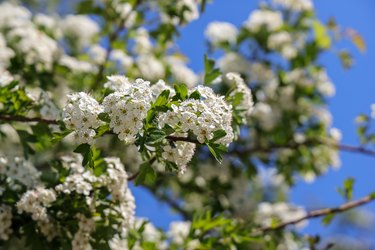
Four species of trees with thorns have been used in New York as landscape trees because of their attractive shapes, pretty flowers or ability to attract wildlife. But the hazards to people and pets posed by the thorns of these trees have pushed these trees out of favor. If you want to keep these thorny trees in your landscapes, install a barrier around the tree trunk, prune low branches and promptly pick up all fallen twigs or branches.
Hawthorn Tree With Thorns
Video of the Day
The hawthorn tree (Crataegus spp.) is a small tree that's a perennial in U.S. Department of Agriculture plant hardiness zones 3 through 8. There are several species of hawthorn including cockspur hawthorn (Crataegus crusgallii, zones 3-7) and lavalle hawthorn (Crataegus lavallei, zones 4-7). that thrive throughout most of New York state. Most species of hawthorn, such as 'Ohio Pioneer' hawthorn (Crataegus punctata 'Ohio Pioneer,' zones 4-7) are thornless.
Video of the Day
The tree's distinguishing characteristics are stiff, zigzagging twigs armed with many sharp thorns up to 3 inches long and clusters of cherry-like red fruits with a center seed that ripen in early autumn. The tree has a scaly bark that's dark brown to dark gray and oval simple leaves.
Honey Locust Tree
The honey locust (Gleditsia triacanthos, USDA zones 3-8) is native to western New York state but has been introduced statewide. Its twigs and branches bear numerous sharp thorns that can grow up to 4 inches long. There are also thornless cultivars of honey locust (Gleditsia triacanthos var. inermis) that are hardy in USDA zones 4 to 9.
Its blackish bark has firm, broad ridges that curl over. It has compound leaves that are around 7 inches long with 18-28 leaflets. Its reddish-brown seed pods grow up to 18 inches long and often twist into a spiral.
Black Locust Tree
The black locust (Robinia pseudoacacia, zones 4-8) was introduced into New York by early European settlers who valued its hard, durable wood for fence building. The tree bears sharp half-inch-long thorns at the base of each of its compound leaves. Its bark is deeply furrowed. There are thornless black locust tree cultivars such as 'Umbraculifera.'
The leaves grow up to 14 inches long with seven to 19 leaflets. The flat, smooth seed pods grow up to 4 inches long. The thorns as well as other plant parts including the bark, seeds and leaves are extremely toxic when ingested and can cause allergic reactions.
Russian Olive Tree
The Russian olive (Elaeagnus angustifolia, zones 2-7) is a thorny tree that was brought into New York in the late 19th century as an ornamental tree prized for its clusters of fragrant white blossoms with yellow centers that attract hummingbirds. It bears inch-long sharp thorns at the base of each cluster of its elongated silver-green leaves. The tree has clusters of silver-green to yellow berries that resemble olives. Birds and mammals relish the berries, which contain seeds that pass unharmed through the digestive tract to be deposited far and wide.
- Missouri Botanical Garden: Crataegus punctata 'Ohio Pioneer'
- Cornell University Woody Plants Database: SEARCH CRITERIA hawthorn, Tree > 30 feet, Tree < 30 feet
- Cornell University Woody Plants Database: Species: Gleditsia triacanthos
- North Carolina State University Cooperative Extension: Robinia pseudoacacia
- North Carolina State University Cooperative Extension: Gleditsia triacanthos var. inermis
- North Carolina State University Cooperative Extension: Elaeagnus angustifolia